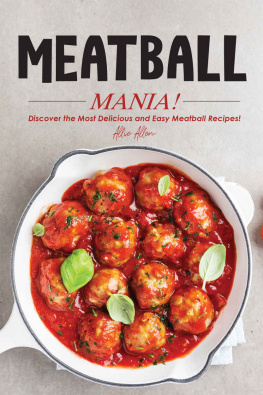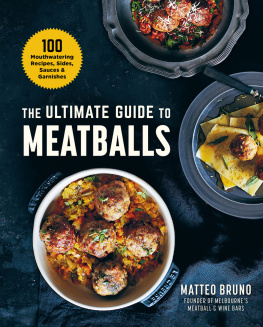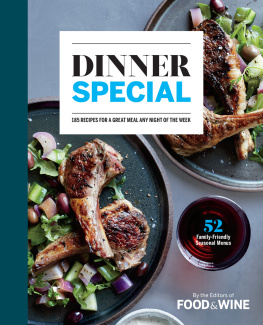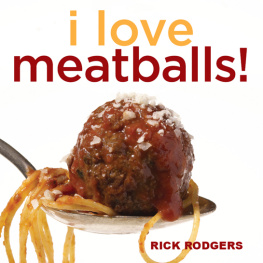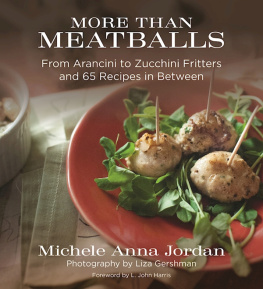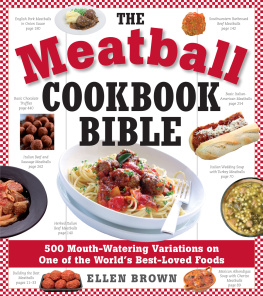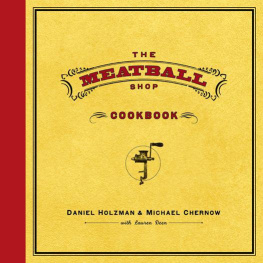
Adeline Myers

Contents

Introduction

We all love meatballs. They evoke memories of our grandmothers kitchens, of family dinners, and of holidays. Meatballs have a charming quality. The humble, misshapen rounds are quaint, delightful, and mysterious. Meatballs feel definitively handmade, a mark of time and love.
The meatball is more than a round ball of meat. On our wide planet they are made with meats, fish, grains, vegetables, and legumes. Their names shine with possibility: albondigas, bitki, frikkadel, kefta, kofta, kufteh, kotlecky, klopsiki, pulpety, polpetes .
The meatball has range and is not as homely as we may think. In cultures where meat has historically been abundant, like Northern Europe, Scandinavia, and North America, meatballs are common comfort food, made with few ingredients and very little fuss by all households. Where meat was scarce, such as in Italy, meatballs included lots of bread, were made on festival days, and were usually small and very special. Where meatballs were made for the banquet tables of kings and noblemen, they were filled with riches like pine nuts, pomegranates, and innumerable spices.
The beauty of a meatball is in its simplicity.
Ground/mashed protein: meat, fish, vegetables, or legumes
Light texture: bread, bread crumbs, flour, starch, or grains
Moisture: milk, water, yogurt, or wine
Binder: whole egg, yolk, white flour, or starch
Depth of flavor: herbs, spices, or salt
These are only guidelines. Many meatballs are made with only the ground protein and spices, with no egg, wheat, or milk. If you are cooking for someone whose dietary choices limit things like egg, gluten, dairy, or meat, you will find plenty of options among the recipes of this book. And do as our meatball-loving ancestors did and change, modify, and make the meatball local to where you live.
I have arranged this book by protein: meat, poultry, fish, and vegetable. Arranged within each chapter are courses: appetizers, soups/stews, sandwiches, and mains. Lastly, within each course, recipes are arranged from light to rich in flavor. Meatballs with sauces of fresh herbs precede creamy gravy dishes. Happy meatball making!

The basic ingredients of meatballs are simple: protein, eggs, breadcrumbs, and seasoning.
Size and Cooking Time

Each recipe indicates the recommended size of the meatball. Cooking times given are for the indicated size. If you make smaller or larger balls, be sure to shorten or lengthen your cooking time.
Three Tips for Forming the Balls
Make them compact, without large cracks.
Use wet hands for neat results; they will be far less sticky.
Make them the same size, so they finish cooking at the same time.
And How to Stuff Them
Stuffed meatballs are a real surprise, often filled with melting cheese. They are easy to make.
a. Form the mixture into a ball.
b. Using a thumb, press a deep hole into the ball. Place the filling inside.
c. Take a little more of the mixture and use it to cover the filling. Roll the whole thing so it is round and compact.
How Do I Know when the Balls are Done?
Meatballs are typically cooked well done. Eventually, you will be able to tell they are done just by poking a meatball. Until then, you can use two approaches.
1) Cut one meatball in half. If it is the same opaque color all the way through, it is done. If not, cook for more time.
2) Use a meat thermometer; recommended USDA temperatures are higher for ground meats than for whole cuts of meat. This is because potential contamination is not only on the surface but on the insides of ground meat. Buy good meat from well-maintained farms and you will worry about this less.
How Do I Freeze Balls?
Its simple, and once they are in your freezer, they are an easy meal, ready to go in just moments. Remember to label them so you remember what they are! I will lay out the variations here:
Basic Freezing Method:
Lay the balls on a baking tray, not touching one another. Freeze, uncovered, for 2 or more hours. It is okay to leave them like this overnight. Remove them from the baking tray into a plastic freezer bag, press the air out, and seal. This way they dont freeze in one big lump. Theyre best eaten from the freezer within 4 months for freshness.
COOKED MEAT OR VEGGIE BALLS:
Use the Basic Freezing Method. Thaw in the fridge, reheat in an oven, or simmer in a sauce until warmed through.
RAW MEAT, FISH, OR VEGGIE BALLS:
Use the Basic Freezing Method. When ready to eat, thaw in the fridge or put frozen balls right into a hot oven, sauce, soup, or deep-fry. You will have to cook them just a bit longer than usual because they are coming from frozen.
BALLS WITH SAUCE:
If they are in sauce, presumably they are already cooked. When cooled, scoop into freezer bags with the sauce and seal so all the air is pressed out. To reheat, thaw and simmer until warmed through.
PAR-COOKED MEATBALLS:
This technique saves the last stage of cooking until after the freezer to eliminate the worry the meatballs may dry out or overcook when reheated. Label the bag so you remember they are only half-cooked. This applies well to meatballs cooked in a skillet before being put in a sauce or baked. Saut, fry, or bake the meatballs as directed. Allow them to cool and use the Basic Freezing Method. When ready to eat, simmer them in sauce or put them directly into the oven. Cook until entirely cooked through.
FREEZING FISH BALLS:
Fish balls can get watery or tough after freezing. This is the best bet: Cook the fish balls by boiling or frying, as the recipe specifies. Remove, drain, and cool on a tray. Follow the Basic Freezing Method. When ready to eat, remove from the freezer and simmer directly in sauce. If serving simply poached, as in fiskeboller, thaw first. Then simmer in water until warmed through.







